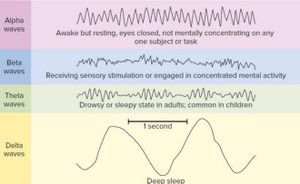Oneirogens: Difference between revisions
mNo edit summary |
mNo edit summary |
||
| Line 7: | Line 7: | ||
* '''Dream herb''' (''Calea zacatechichi synonym. ternifolia'') | * '''Dream herb''' (''Calea zacatechichi synonym. ternifolia'') | ||
* '''African dream herb''' (''Entada rheedii'') | * '''African dream herb''' (''Entada rheedii'') | ||
* '''Mugwort''' (''Artemisia vulgaris'') | * '''Mugwort''' (''Artemisia vulgaris'') - Thujone, the primary component of absinthe, is present in mugwort oil and in Korean tradition has been used in late night steam baths to encourage vivid dreams. | ||
== Chemicals == | == Chemicals == | ||
Revision as of 02:58, 31 December 2022
An oneirogen, is a substance or experience which enhances dream states. There are many suggested non-psychedelic plants, chemicals and experiences which are thought to induce an oneirogenic states, below is a compendium of those with the most scientific evidence:
Plants
Plants contain a variety of chemicals which can work concurrently via the entourage effects. The main plants which are suspected of having oneirogenic properties include:
- Dream herb (Calea zacatechichi synonym. ternifolia)
- African dream herb (Entada rheedii)
- Mugwort (Artemisia vulgaris) - Thujone, the primary component of absinthe, is present in mugwort oil and in Korean tradition has been used in late night steam baths to encourage vivid dreams.
Chemicals
- Galantamine - substantially increases the frequency of lucid dreams with a minimal side effect profile[1].
Dream Enhancement
There is very little scientific data on dream enhancement. One reason for this is during REM sleep, the skeletal muscles of the sleeping body are inhibited which makes it otherwise impossible for the dreamer to signal that they are in a lucid state[2]. Although this has been known to malfunction in atypicals in the form of sleepwalking.
Simulation theory
There has been some recent scientific interest on the idea that REM dreams are a kind of a simulation of the real world on a higher cognitive level implies that dreaming could alter waking performance[2].
References
- ↑ Pre-sleep treatment with galantamine stimulates lucid dreaming: A double-blind, placebo-controlled, crossover study. LaBerge S, LaMarca K, Baird B. PLoS One. 2018 Aug 8;13(8):e0201246. doi: 10.1371/journal.pone.0201246. PMID: 30089135; PMCID: PMC6082533. Accessed on 6 December 2022 via: https://www.ncbi.nlm.nih.gov/pmc/articles/PMC6082533/
- ↑ 2.0 2.1 Lucid dreaming: Neural virtual reality as a mechanism for performance enhancement. Commentary on “The neurobiology of consciousness: Lucid dreaming wakes up” by J. Allan Hobson, Daniel Erlacher1 & Heather Chapin2, 1Institute of Sports and Sports Science, Heidelberg University, Germany 2Florida Atlantic University, USA
